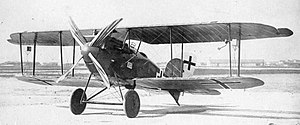| Aviatik D.VII | |
|---|---|

| |
| A left-front oblique view of the Aviatik D.VII | |
| Role | Experimental single-seat biplane fighter |
| National origin | Germany |
| Manufacturer | Aviatik |
| First flight | 1918 |
| Number built | 1 |
| Developed from | Aviatik D.VI |
The Aviatik D.VII was a prototype German single-seat biplane fighter aircraft built by Aviatik in the last year of the First World War. It could not participate in the Third Fighter Competition of October 1918 because it used the wrong engine and it saw no military service, although 50 aircraft were found in storage after the war. The only real major change from the earlier Aviatik D.VI was a completely new tail structure.
Specifications
[edit]Data from The Complete Book of Fighters: An Illustrated Encyclopedia of Every Fighter Built and Flown[1]
General characteristics
- Crew: 1
- Length: 6.10 m (20 ft 0 in)
- Wingspan: 9.66 m (31 ft 8 in)
- Height: 2.50 m (8 ft 2 in)
- Empty weight: 745 kg (1,642 lb)
- Max takeoff weight: 945 kg (2,083 lb)
- Powerplant: 1 × liquid-cooled Benz Bz.IIIbm geared V-8 engine , 145 kW (195 hp)
- Propellers: 2-bladed fixed-pitch propeller
Performance
- Maximum speed: 192 km/h (119 mph, 104 kn)
- Endurance: c. 1 hour[2]
- Time to altitude: 24 minutes to 6,000 m (20,000 ft)
Armament
2 × fixed, synchronised 7.92 mm (0.312 in) LMG 08/15 "Spandau" machine guns
References
[edit]Bibliography
[edit]- Gray, Peter & Thetford, Owen (1987) [1970]. German Aircraft of the First World War (2nd ed.). London: Putnam. ISBN 0-85177-809-7.
- Green, William & Swanborough, Gordon (2001) [1994]. The Complete Book of Fighters: An Illustrated Encyclopedia of Every Fighter Built and Flown (Revised and Updated ed.). London: Salamander Books. ISBN 1-84065-269-1.
- Herris, Jack (2023). Aviatik Aircraft of WWI: A Centennial Perspective on Great War Airplanes. Great War Aviation Centennial Series. Vol. 10 (2nd ed.). n.p.: Aeronaut Books. ISBN 978-1-953201-59-1.
Well, that’s interesting to know that Psilotum nudum are known as whisk ferns. Psilotum nudum is the commoner species of the two. While the P. flaccidum is a rare species and is found in the tropical islands. Both the species are usually epiphytic in habit and grow upon tree ferns. These species may also be terrestrial and grow in humus or in the crevices of the rocks.
View the detailed Guide of Psilotum nudum: Detailed Study Of Psilotum Nudum (Whisk Fern), Classification, Anatomy, Reproduction